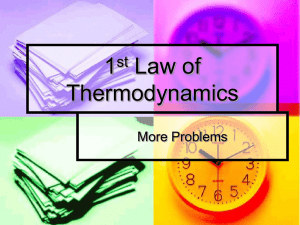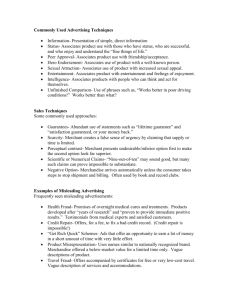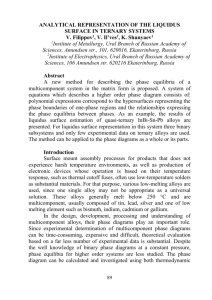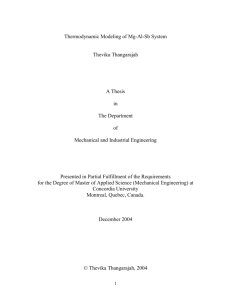ARBITRARY STOICHIOMETRY ASSOCIATES AND MIXTURE
advertisement
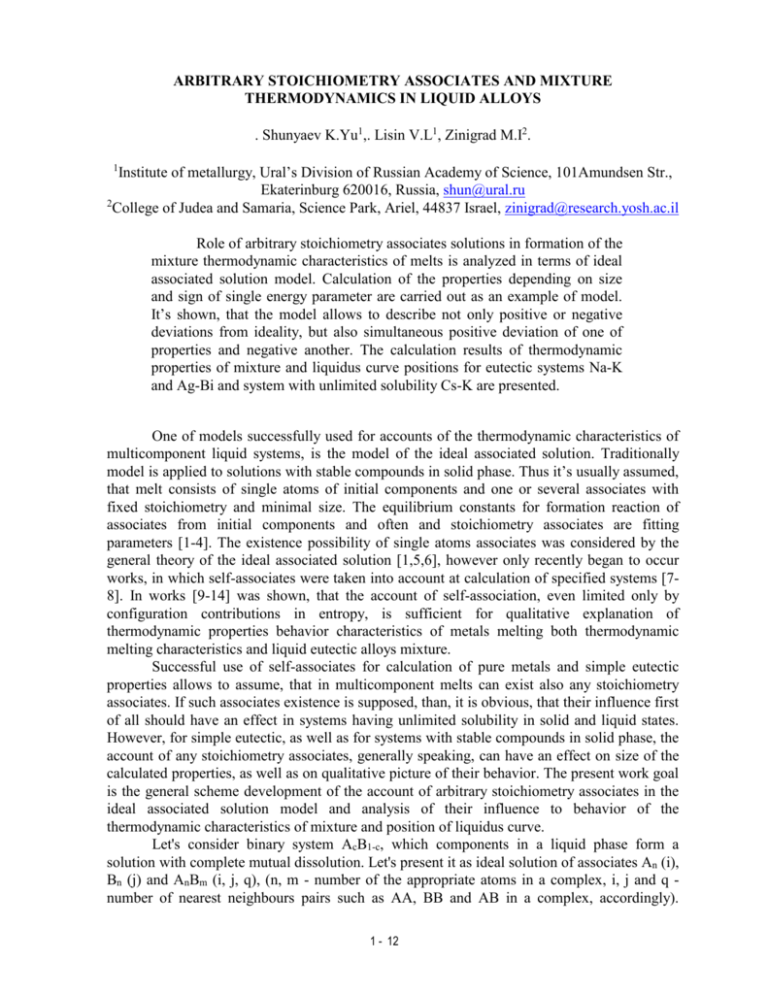
ARBITRARY STOICHIOMETRY ASSOCIATES AND MIXTURE THERMODYNAMICS IN LIQUID ALLOYS . Shunyaev K.Yu1,. Lisin V.L1, Zinigrad M.I2. Institute of metallurgy, Ural’s Division of Russian Academy of Science, 101Amundsen Str., Ekaterinburg 620016, Russia, shun@ural.ru 2 College of Judea and Samaria, Science Park, Ariel, 44837 Israel, zinigrad@research.yosh.ac.il 1 Role of arbitrary stoichiometry associates solutions in formation of the mixture thermodynamic characteristics of melts is analyzed in terms of ideal associated solution model. Calculation of the properties depending on size and sign of single energy parameter are carried out as an example of model. It’s shown, that the model allows to describe not only positive or negative deviations from ideality, but also simultaneous positive deviation of one of properties and negative another. The calculation results of thermodynamic properties of mixture and liquidus curve positions for eutectic systems Na-K and Ag-Bi and system with unlimited solubility Cs-K are presented. One of models successfully used for accounts of the thermodynamic characteristics of multicomponent liquid systems, is the model of the ideal associated solution. Traditionally model is applied to solutions with stable compounds in solid phase. Thus it’s usually assumed, that melt consists of single atoms of initial components and one or several associates with fixed stoichiometry and minimal size. The equilibrium constants for formation reaction of associates from initial components and often and stoichiometry associates are fitting parameters [1-4]. The existence possibility of single atoms associates was considered by the general theory of the ideal associated solution [1,5,6], however only recently began to occur works, in which self-associates were taken into account at calculation of specified systems [78]. In works [9-14] was shown, that the account of self-association, even limited only by configuration contributions in entropy, is sufficient for qualitative explanation of thermodynamic properties behavior characteristics of metals melting both thermodynamic melting characteristics and liquid eutectic alloys mixture. Successful use of self-associates for calculation of pure metals and simple eutectic properties allows to assume, that in multicomponent melts can exist also any stoichiometry associates. If such associates existence is supposed, than, it is obvious, that their influence first of all should have an effect in systems having unlimited solubility in solid and liquid states. However, for simple eutectic, as well as for systems with stable compounds in solid phase, the account of any stoichiometry associates, generally speaking, can have an effect on size of the calculated properties, as well as on qualitative picture of their behavior. The present work goal is the general scheme development of the account of arbitrary stoichiometry associates in the ideal associated solution model and analysis of their influence to behavior of the thermodynamic characteristics of mixture and position of liquidus curve. Let's consider binary system AcB1-c, which components in a liquid phase form a solution with complete mutual dissolution. Let's present it as ideal solution of associates An (i), Bn (j) and AnBm (i, j, q), (n, m - number of the appropriate atoms in a complex, i, j and q number of nearest neighbours pairs such as AA, BB and AB in a complex, accordingly). 1 - 12 Accepting the energy of a complex as determined by the pairs energy sum of nearest neighbours and limiting entropy only by configuration contributions, we obtain mole fractions of complexes related by following equations [10]: i x An ,i K An ,i x An1 exp A x An1 t Ai x An1 kT j x Bn , j K Bn , j x Bn1 exp B x Bn1 t Bj x Bn1 (1) kT i B j AB q n m i j q n m x An Bm (i, j , q ) K An Bm x An1 x Bm1 exp A x A1 x B1 t A t B t AB x A1 x B1 kT Where x An,ш ; x Bn, j ; x An Bm ; x A1 ; x B1 - mole fractions of complexes An, i, B n, j, AnBm and of single atoms A1 and B1, accordingly, A, B and AB – bond energy of nearest neighbours pairs AA, BB and AB taken with opposite sign, K An,i ; K Bn,i ; K An Bm - constants of appropriate equilibrium. Then the balance equations system for definition of single atoms concentration in solution has the following form: x n c i An ,i x B n , j x An Bm 1 n j n ,m i , j ,q nx x n i n An ,i i An ,i nx An Bm (2) n ,m i , j ,q x B n , j (n m) x An Bm n j n ,m i , j ,q The equations system solution (2) with the account of (1) allows to find mole fraction of single atoms in solution. Then it’s easy to calculate the thermodynamic characteristics of system (see, for example, [1-4, 10-13]). For realization of calculations it’s necessary to know energy parameters A, B and AB, and also nearest neighbours pairs number of a various type in associates. The energy parameters A, and B can be estimated from pure components melting temperatures [9]. Then, as varied parameter remains only AB. It is possible to calculate total number of pairs in associate in assumption, that the appropriate crystal local structure remains the in a liquid [9, 12]. For the preliminary analysis of opportunities of model it is possible to choose linear chain approximation for associate structure, as it was done in [10] for simple eutectic. Such simplification allows to carry out summation in (2) easily. Thus, as shows the analysis, which has been carried out in [10], the accuracy loss for the calculated properties does not exceed 10 %. Some properties calculation results for model alloy which components have melting temperatures 700 and 1000 K are shown at figures 1-4 and in the table 1. Parameters A, and B were determined from melting temperatures of components, and parameter W=[AB – 0.5(A + B)] was varied. As well as it was expected, the model allows to describe both positive, and negative deviations from ideality. Thus the negative deviations can be arbitrary large, and at the large positive W values behaviour of the mixture thermodynamic characteristics becomes same, as for systems with strong interaction of components. Other situation is observed at negative W values, i.e. when the formation of pairs such as AB is energetically unprofitable. The mixture enthalpy positive value growth take 1 - 13 place at small W values of is observed as long as the energy loss can be compensated by the configuration entropy. Mixture enthalpy begins to decrease at the further W values increase. Mixture entropy also passes through maximum, but at others, much smaller W values, while activity of components and mixture free energy change monotonously (table 1). Moreover, it has appeared, that the model allows to describe a situation, when mixture enthalpy is negative, and components activities deviations from the Raul law are the positive. It is an additional illustration of that circumstance, that the offered model, in spite of the fact that it contains only one varied parameter, such as interchange energy, is capable to explain much more various behaviour of properties, than other similar models. In difference, for example, from model of a regular solution, where the sign of all properties deviation from ideality is determined by energy parameter sign, in the model, considered in present work, such unequivocal dependence is not present. The value of property is defined as result from the several contributions, say, of direct pair contribution to energy and indirect configuration contribution. Thus the result depends on energy parameter value, melt temperatures and component melting temperature. The calculations of mixture thermodynamic properties and liquidus curve position for binary Na-K, Ag-Bi and Cs-K alloys were carried out. The Na-K is eutectic system [15]. Its components are completely soluble in a liquid phase and practically are insoluble in solid state. The thermodynamic characteristics of mixture are practically symmetric relatively equiatomic composition. The calculation results, which have been carried out by offered model, are given in figures 5-7. It follows from comparison with experiment, that the model in general reproduces behaviour of properties concentration dependencies and liquidus curve position. It is obvious, that for the good quantitative agreement between calculated and experimental results, the account of mixed associates with various stoichiometry appears to be necessary. The offered model clearly demonstrates importance of the autoassociation effects account at calculation of eutectic systems properties and allows to carry out the calculation of mixture thermodynamic characteristics, as well as melting diagrams basing on the same concepts. The values of mixture thermodynamic characteristics and liquidus curve position for binary system Ag-Bi calculated with parameter W = -3500 joule/mole are displayed in the table 2. The results of calculations by model with account only autoassociation of components are given for comparison. It’s can be seen, that the calculated results become much closer to the experimental vales for all set of the calculated properties. The Cs-K system has unlimited solubility in solid and liquid state close to liquidus curve. The calculated results of mixture thermodynamic characteristics compared with experimental data for this system (W parameter was accepted as -150 cal/mole) are given in the table 3. It can be seen from the table 3, that the calculated results are in satisfactory agreement with experimental data in this case too. The results of work show, that the offered variant of the ideal associated solution model can be applied for absolutely new objects for this model: eutectic systems and systems with unlimited solubility. Thus the qualitative interpretation of the thermodynamic properties, as well as quantitative calculations are possible. The work is realized within the framework grant " Integration” (project № 00-15-92420) 1 - 14 REFERANCES 1. Prigogine I., Defay R. Chemical thermodynamics, Longmans Green and Co., London, 1954. 2. Wasai K., Mukai K. // J.Jap. Inst. Metals, 1982, v.46, № 3, p.266-274. 3. Sommer F., Z.Metallkunde // 1982, v.73, № 2, p.72-86. 4. Schmid R., Chang Y.A. // CALPHAD, 1985, v.9, № 4, p.363-382. 5. H.Kehiaian // Bull. Acad. Polon. Sci., Ser. sci. chim., 1964, v.12, №7, p.497-501. 6. Morachevsky A.G., Mokrievich A.G., Majorova E.A. // JOCH, 1989, v.59, № 9, p. 19271934. (in Russ.) 7. Ivanov M. // Z.Metallkunde, 1991, v.82, № 1, p.53-58. 8. Singh, R.N., Sommer F. // Z.Metallkunde, 1992, v.83, № 7, p.533-540. 9. N.K. Tkachev, K.Yu. Shunyaev, A.N. Men, N.A. Vatolin. //Melts, 1988, v.2, №.1, p. 3-11. 10. N.K. Tkachev, K.Yu. Shunyaev, A.N. Men, N.A. Vatolin. // DAN USSR, 1988, v.302, №1, p. 153-157. 11. K.Yu. Shunyaev, N.A. Vatolin // DAN RAS, 1993, v 332, №2, p. 167-169. 12. K.Yu. Shunyaev, N.A. Vatolin //, Melts, 1993, №5, p. 28-31. 13. K.Yu. Shunyaev, N.A. Vatolin // Metals, 1995, №5, p. 96-103. (in Russ.) 14. Shunyaev K.Yu., Tkachev N.C., Vatolin N.A. // Thermochimica Acta, 1998, v.314, p.299306. 15. Hultgren R., Desai P., Hawkins D., Gleiser M., Kelley K. Selected values of the thermodynamic properties of binary alloys. Metal Park; Ohio: ASM, 1973. 16. Alblas B.P., van der Lugt W. Small-angle x-ray scattering from sodium-potassium alloys // J. Phys. F, 1980, V.10, P.531. 17. Kagan D.N. High temperatures thermal physics, 1988, v.26, №3, p.478-491. (in Russ.) 1 - 15 Table 1. Dependence of properties for equiatomic composition melt on energy parameter value W at T=1100 K. -60000 -30000 -10000 -6000 -3000 -2000 0 3000 10000 30000 W Дж/моль 289 515 641 534 370 295 104 -300 -1987 -12460 HM Дж/моль -3535 -3670 -4159 -4382 -4600 -4684 -4872 -5210 -6329 -12590 GM Дж/моль 3.476 3.805 4.364 4.469 4.518 4.526 4.524 4.464 3.947 0.122 SM Дж/мольK 0.68 0.669 0.635 0.619 0.605 0.54 0.587 0.566 0.501 0.253 аА Table 2. The calculated and experimental properties of liquid Ag-Bi alloys at T=1000K. 1 – calculation with self-associates account only; 2 - calculation with the arbitrary stoichiometry associates account. The experimental results are taken from [15]. 0.2 0.3 0.4 0.5 0.6 0.7 0.8 0.9 1.0 cBi 398 474 514 525 508 462 380 246 0 H1 Дж/моль 276 352 396 410 395 350 273 160 0 H2 473 699 946 1540 1711 1582 1046 0 1222210 Hэксп 1728 2017 2175 2226 2177 2022 1735 1243 0 -G1 Дж/моль 3047 3655 3992 4102 3995 3660 3053 2055 0 -G2 4305 4489 5100 4515 3920 3096 1954 0 49451050 -Gэксп 0.568 0.653 0.715 0.765 0.808 0.847 0.887 0.932 1.0 aBi-1 0.330 0.437 0.528 0.610 0.687 0.76 0.834 0.911 1.0 aBi-2 0.231 0.419 0.579 0.743 0.802 0.869 0.930 1.0 0.6790.08 aBi-эксп 0.888 0.849 0.809 0.766 0.716 0.655 0.569 0.424 0 aAg-1 0.834 0.761 0.687 0.611 0.529 0.437 0.330 0.195 0 aAg-2 0.734 0.604 0.509 0.402 0.348 0.272 0.184 0 0.4480.05 aAg-эксп Table 3. The calculated and experimental properties of liquid Cs-K alloys at T=384K. H, G –cal/mole. Experiment H [15], activities [17]. K H Hэкс -G aK aK-экс aCs aCs-экс Scc(0) 0 0 0.1 9.4 0.2 16.0 0.3 20.5 0.4 23.1 0.5 24.0 0.6 23.1 0.7 20.5 0.8 16.1 0.9 9.5 1 0 0 8 14 19 23 28 27 23 17 0 0 194 290 350 381 265 392 381 349 290 194 0 0 0 1 1 0 0.18 0.11 0.91 0.90 0.12 0.31 0.22 0.83 0.80 0.22 0.42 0.32 0.76 0.70 0.29 0.51 0.42 0.68 0.61 0.34 0.60 0.50 0.60 0.52 0.35 0.68 0.58 0.51 0.43 0.34 0.76 0.69 0.42 0.32 0.29 0.83 0.79 0.31 0.20 0.22 0.91 0.90 0.18 0.10 0.12 1 1 0 0 0 1 - 16 1 Scc(0) aA, aB 0,9 0,4 2 0,35 0,8 0,7 0,6 1 3 0,3 2 0,25 0,5 5 0,2 0,1 6 0,1 5 0,15 4 0,3 4 0,2 3 0,4 6 0,05 0 0 0 0,5 0 1 0,2 0,4 c 0,6 A 0,8 1 cA Fig. 1. Components activity of model alloy at T=1100 K at various energy parameter values: W =-3000 (2); 3000 (3); 10000 (4); 13000 (5); 30000 (6). T, K 1200 H 1000 Дж/моль 500 2 0.2 3 0.4 -1000 -1500 1000 1 0 -500 0 Fig. 2. Long wave limit of the partial structure factor concentration - concentration of model alloy. Curves numbers the same, as in a fig. 1, dash - ideal solution. cA 0.6 0.8 1 800 600 4 -2000 400 -2500 -3000 5 200 -3500 0 0 0.2 0.4 cA 0.6 0.8 1 Fig. 3. Mixing enthalpy dependence of model Fig. 4. Liquidus curve position for simple alloy at T=1100 and various values of energy eutectic. Downwards curves for W = +3000; parameter: W=0 (curve 1), 3000 - (3), 10000 0; -3000; -30000 - (4), 13000 - (5), -3000 - (2). 1 - 17 aK, aNa 1 Scc(0) 1 1 0.8 0,8 0.6 0,6 2 0.4 0,4 0.2 3 0,2 0 0 0 0 0,5 cNa 1 Fig. 5. Activity of components for liquid NaK alloys at T=384K. A continuous curve is calculation in model with self-associates only, dashed curve is model with mixed associates, ●, + - experimental activities of K and Na, accordingly [15]. 0.5 cNa 1 Fig. 6. Long wave limit of the partial structural factor concentration - concentration of liquid Na-K alloys at T=384K, (1) - model with self-associates only, (2) – model with mixed associates, (3) - ideal solution, o, x experiment [16]. Fig. 7. The phase diagram of a binary Na-K alloy [12] (X - liquidus curve position calculation in model which self-associates only, O - calculation with the arbitrary stoichiometry associates account). 1 - 18

